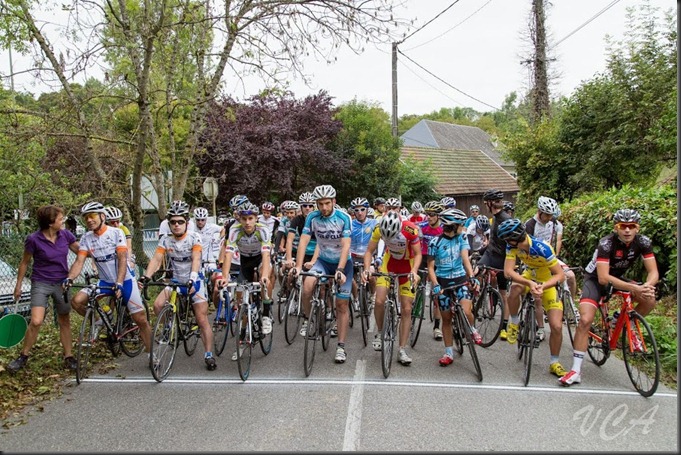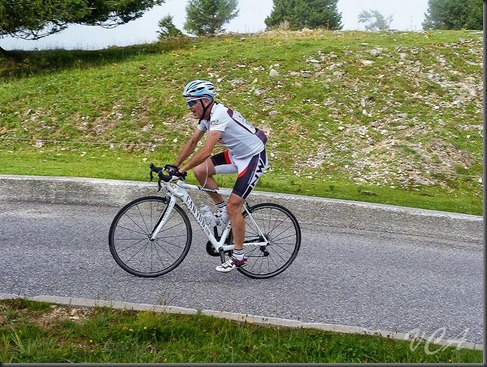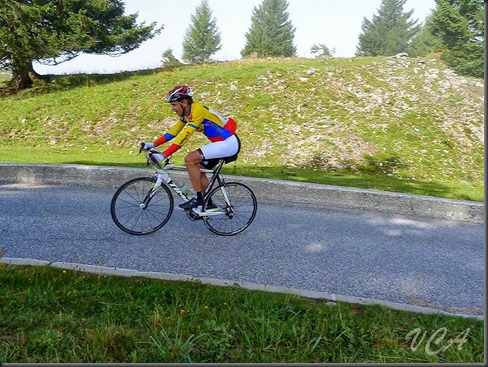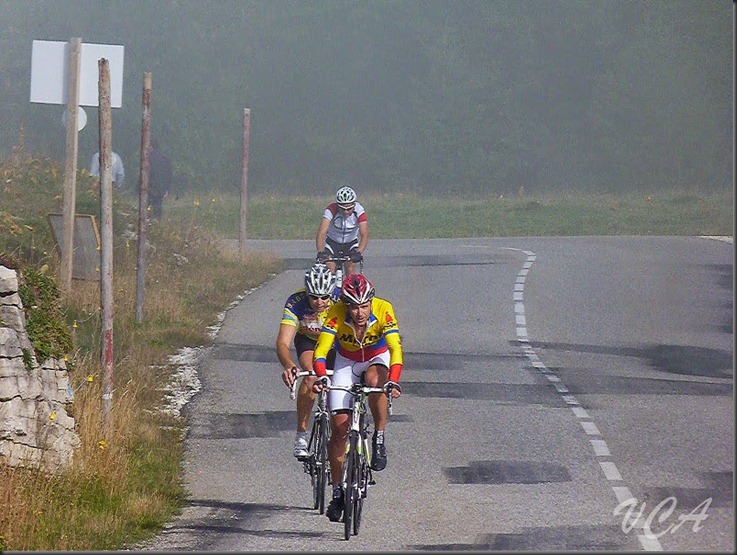This event was shaping up to be the ultimate test for ketosis – a “make or break” situation. The race is simply 14 km as hard as possible uphill – with roughly 1km vertical – organised by the Vélo Club Annecy (Founded 1888). For once at least the weather was good – last year had been a torrential downpour. Often the dates conflict with the Marsielles “Bosses du 13” but this year they were apart. Semnoz is the long wedge of a hill in the far distance – middle of the image – climbing from the far end of the lake – right to left with the summit in the clouds. 5 years ago I set my best ever time of 57 mins 25 secs and had the surprise of an average heart rate of 167 bpm sustained over this period. It’s a surprise because my maximum heart rate on the bike was just 176 bpm at that time (tested physically – no formulas used) and that meant 95% max had been sustained. The British Cycling coaches and Sky Team currently define 94% and above as “maxing out” and so only sustainable for a very short burst – however they do say that pros can sustain over 94% effort – so it’s not so unusual. This was the one and only time ever that I’d averaged within this heart rate zone for any sustained period. The effort was so violent that I had a post exercise asthma attack immediately after stopping when crossing the finish line. The physical pain of such an effort etches itself into your brain with each and every corner and change of gradient of the road – so that when you travel that road again it replays like an old record in your head. Views from the Semnoz
During the week my preparation had been a long hard ride on the Thursday covering 120 km and 2800 m climbing. The trip went clockwise around the Tarantaise valleys from Aime to Albertville then climbed up to Beaufort and the scary “Col du Pré” – which is one of those endless 11% gradient climbs (11 km). This would entail about 6 hours of cycling (not counting stops) but from the moment I started pedalling it was clear there was no power in the legs. Dealing with headwinds and hills when the legs feel empty is quite a challenge. It appeared that the problem was being caused by ketosis – or rather the body struggling to adapt properly to ketosis. My diet which was by now almost completely free of carbohydrates and other insulin stimulating factors appeared to be leaving me fundamentally short of strength. I qualify this carefully because it wasn’t an “energy dip” as happens with insulin spikes and crashes – it actually felt like there was not much power in the legs. My head felt fine and the answer was to drop down a gear and just use less force on the pedals – but also pedal at a higher cadence. This of course only really becomes a bit of a problem at 11% gradients when there isn’t a small enough gear ratio left to step down to. I made a stop at Beaufort village to refill the water bottles but also drank a fresh orange juice. Drinks containing sugar are permitted when in ketosis once you have exercised hard for a few hours and have built up a “carb debt” in the body. This was just prior to the Col du Pré climb and just that one drink made a significant difference as I’d been starting to struggle to stay motivated and focused. Just over the top of the Col du Pré 90 minute climb is another café and so I stopped there and repeated this exercise with an apple juice. This drink would help to resist the cold as the sun was hiding behind clouds and it would see me up to the top of the Cormet de Roselend at 2000m altitude. I didn’t have time to hang around due to the sun going down so it was non-stop the rest of the way – arriving home at 7:58pm, exactly the moment the street lights switched on. By this time I was now pretty convinced that ketosis (or poor adaptation) was leaving me pretty weak at times – but something didn’t quite add up! Sky when crossing the Cormet de Roselend
One week earlier I’d cycled up the Galibier with Chris and friends in a ketosis state and had felt even stronger than usual – but I’d gone through the same tiredness during the week before that too. It suddenly dawned on me that the tiredness was perhaps not due to ketosis but to intermittent fasting. This was obvious because the evening before the Galibier I stopped the fasting to make sure I was eating enough. On the days I’d done training rides on each occasion I’d been fasting until lunch time from around 8pm the evening before. Fasting for more than one whole day – when exercise is continued – leads to a general fatigue but it hadn’t dawned on me that consistent intermittent fasting could have a similar effect – but only actually noticeable when exercising. On each occasion during training for both running and cycling everything felt great until starting the workout – where it would be discovered that there was no strength. With running however I could get up to fast sprint intervals or a consistent fast pace after about a 20 minute warm up. Running can be influenced enormously by technique though – which once again masks certain issues here – whereas cycling needs leg strength. Taking everything into consideration the plan was to remain fully in ketosis for the Semnoz climb but to ensure enough calories were consumed both the evening before and in the morning a couple of hours before the race. No carbohydrates would be used. This felt like a very scary proposition considering how brutal the race is and that any effort above or including “upper aerobic” level (zone 4) is supposed to be fuelled at least 70% directly by glucose. My expectations were that it was going to be a disaster and that I’d either be last or abandon in disgust. I anticipated my legs just not working right from the start. The experiment had to be done though – it’s the only way to learn. Here is a table of recently revised heart rate performance zones from authorities on bike training such as the coaches of British Cycling and the Sky racing team, which now use different heart rate percentages (from crude standard steps of 10%) to determine their training zones. They consider that these percentages more closely relate to when and where physiological changes are actually occurring during exercise.
These revised zones are:
Zone 1, 60 / 65% Easy Ride/Recovery
Zone 2, 65 / 75% Fat Burning
Zone 3, 75 / 82% Lower Aerobic
Zone 4, 82 / 89% Upper Aerobic (Threshold)
Zone 5, 89 / 94% Anaerobic
Zone 6, 94%+ Maximal Having parked up for the night just about 50 metres from the start line and next to the Semnoz camp site I was set for a very peaceful sleep and a relaxed preparation in the morning. Along with a cooked breakfast on a camping stove I had some special ketone supplements (pictured below). The chocolate and coconut “fat bombs” were made principally with coconut oil which is especially rich in MCT (Medium Chain Triglycerides) which convert directly into ketones for fuel in the body. I couldn’t eat carbs but at least I could add ketones to those my body might or might not be producing. The ketones would be produced from the MCT oils and be made available directly from the liver as the most preferred fuel for both the brain and the heart. Prior to the actual race I had a very brief warm up along with Chris and true to expectations the legs took a moment or two to get going. There was definitely no “carb buzz” and when pushing hard on the pedals it felt more like the legs might seize up rather than loosen up. Chris was planning to use his power meter but ran into technical difficulties when his batteries ran out before the start. His plan however was to save energy by pacing the start and then to finish strongly over the last three kilometres. As for me there was no plan other than to avoid carbs and hope for the best. The race begins with a mass start and I made sure not to be at the front so as not to be flattened as everyone overtook! The rest of the race was a bit of a shock and surprise. Despite the initial reluctance of the legs to work I quickly settled into a rhythm about 50 metres behind Chris and then kept him well in sight for the next 9 kilometres – catching up more people than were catching me. This was not what I expected. Since committing to a proper ketogenic diet almost a month earlier my heart rate had never managed to climb above 165 bpm on any occasion and I was beginning to believe that this is how it would be with ketosis. I had one earphone in to hear my heart rate information and very shortly after the start the voice said “170 beats per minute!”. OK, well that was a surprise – especially as I was not breathing anything like as hard as that would normally entail. I used the lesson learned from accompanying Chris up the Galibier when he was using his power meter (and Chris Froome on the Vuelta!) and so when arriving on flat sections kept up the power and accelerated – this being where most time is gained. One guy spotted this and used me for drafting – then each time I had to slow down for the next climb he would shoot off ahead leaving me behind – which was a bit annoying to say the least. Eventually I’d had enough of this cyclist from the Pringy club (they always beat me anyway!) and so on the next flat bit I crossed over to the other side of the road and sprinted away – heart rate going up to 172 bpm on the flats. My maximum recorded heart rate in the past few years has been 174 bpm. Only in the last kilometre of the race was I overtaken by two guys who I’d previously overtaken a few kilometres earlier. The Pringy club guy fortunately never caught up again. In the end my accurate time was 58:53 (officially recorded as 58:57) so it was only around 90 seconds off my record from 5 years earlier. My average heart rate was 166 bpm – this being 95.4% max!!!!!! Overall I came 45th out of 74 starters “scratch-classement” and 8th in age category out of 22 aged 50 or over. Most importantly I felt much better during the event than I’d ever felt on any previous occasion. There was no post exercise asthma. This is only the second time ever that I’ve had a sustained heart rate as high as this – and when in full ketosis this time – completely contrary to everything that was expected. Chris managed to end up with an photo but apparently I was too fast for the camera…

 After the race I drank some orange juice and ate a little cheese – but couldn’t face too much food at the reception. Chris and I then headed off for a 70km tour taking us around Lake Annecy and over the Col du Forclaz which is much more vicious than the Semnoz – with most of its 9km at between 10% to 11% and with some ridiculously steep parts. It was also hot by this time and I was running purely on ketones as I had no sugar. There was no energy dip – but my leg fitness was being stretched to the limit with only 3000 km of training this year. At the top of the monster Forclaz – 2 hours after leaving Semnoz – it was a stunning view and we found a very friendly café where I indulged in extremely inappropriate eating – with a cheese and egg filled crèpe, ice cream, fruit drink and a coffee. Chris had exactly the same as me but insisted on paying for everything. After a relaxing meal we then climbed up the road even higher to the paragliding take off zone – going up 18% gradients! The following view is from there as is the view of Semnoz at the very top of this post…
After the race I drank some orange juice and ate a little cheese – but couldn’t face too much food at the reception. Chris and I then headed off for a 70km tour taking us around Lake Annecy and over the Col du Forclaz which is much more vicious than the Semnoz – with most of its 9km at between 10% to 11% and with some ridiculously steep parts. It was also hot by this time and I was running purely on ketones as I had no sugar. There was no energy dip – but my leg fitness was being stretched to the limit with only 3000 km of training this year. At the top of the monster Forclaz – 2 hours after leaving Semnoz – it was a stunning view and we found a very friendly café where I indulged in extremely inappropriate eating – with a cheese and egg filled crèpe, ice cream, fruit drink and a coffee. Chris had exactly the same as me but insisted on paying for everything. After a relaxing meal we then climbed up the road even higher to the paragliding take off zone – going up 18% gradients! The following view is from there as is the view of Semnoz at the very top of this post… Annecy is on the left of the above image just at the other side of the lake and it was fast and downhill most of the way there (helped by Chris pulling from the front of course!) The lunch break set us up with plenty of energy to fight with the horribly aggressive motorists in overcrowded Annecy and that rounded off a perfect day. When I got home I checked my ketosis level on a digital breathalyser unit and found it to be very high at 0.03% BAC (Blood Alcohol Concentration) – which would put me in jail for driving in France if the device was detecting ethanol (alcohol) instead of acetone in my breath (from ketones). At night I was still at 0.03% BAC and next morning the same. Only after a late lunch on Monday did ketosis go down to 0.02% BAC. This proves Dr Attia’s observations that when a carb debt is generated during exercise you can eat carbs without coming out of ketosis. Phinney however warns people never to deviate from a strict ketosis diet because once carbs are eaten it takes one or two weeks to get back into ketosis. Phinney must be referring to sedentary people though. Attia is definitely referring to sports and recommends supplementing with carbs during sport – but usually not for the first two hours. I can certainly now tell when I’ve not eaten enough but there are no energy crashes comparable to those produced by carbs and insulin spikes – and there is no bonking. The mental state remains strong even when low on food and there are no headaches or any other physical complaints other than lack of strength when calorie intake is too low. This last test has proven to me categorically that Attia, Volek and Phinney are correct. There was nothing vague about the very surprising outcome. (An acetone level of 1 mg/dL is 0.172 mmol/L and 10mg/dL = 0.1g/L = 0.01% BAC) 0.01% BAC = 1.72 mmol/l
0.02% BAC = 3.44 mmol/l 0.03% BAC = 5.16 mmol/l 0.04% BAC = 6.88 mmol/l 0.05% BAC = 8.60 mmol/l From Volek and Phinney: Nutritional ketosis begins at 0.5 mmol/l and up to 3 mmol/l Post exercise Ketosis is around 2.5 to 3 mmol/l Starvation (Fasting) ketosis is 3 to around 10 mmol/l A good guide seems to be that if your objective is to lose weight you are aiming for 3.5 mmol/L or over but for most purposes and most benefits between 0.5 and 3.0 is ideal. Apparently I didn’t escape the camera after all… 


